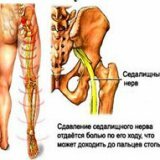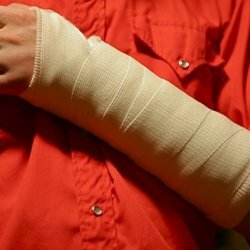Causes of pinch of the sciatic nerve

Sometimes, in the spine, adjacent vertebrae, hernias, spasms or protrusions can squeeze the nerve endings that move away from the spinal cord, causing the most acute pain syndromes. This condition is called pinching the nerve in the spine.
The most frequent and common forms of pinching of the nerve in the spine are pinching of the cervical nerve and sciatic nerve.
Pinch of the sciatic nerve is also called pinching the nerve in the lower back or sciatica.
When this nerve is trapped, the following symptoms appear: limited leg mobility, weakness, burning, shooting pain and tingling. Especially the pain manifests itself in the standing position. Usually all these symptoms appear only in one leg and are amplified by laughter, sneezing and coughing.
Intensity of manifestation of pinching of the sciatic nerve depends on the size of the protrusion, the absence or presence of a hernia and a number of other factors. There are cases when pinching is accompanied by sciatica nerve inflammation. Cases with inflammation are called radiculitis. And the remaining cases of pinching, without inflammation, are called radiculopathy.
Since the main weight of the body falls on the lumbosacral part of the spine, pinching of the nerve in the lower back or sciatica is the most common case of radiculitis and radiculopathy. Therefore pinch of the sciatic nerve often occurs in people who are overweight. In cases of diagnosis of sciatica in people with overweight in the course of treatment include procedures by which to eliminate excess weight, such as nutrition correction, acupuncture and herbal medicine.
The content of the course of treatment as a whole depends on the cause of pinching of the sciatic nerve.
In the most frequent cases, the main cause of sciatica appears acute osteochondrosis in the form of intervertebral hernia or protrusion. Then a complex treatment is prescribed, including a huge number of procedures, such as therapeutic exercises and phytotherapy. If there is a hernia, then apply manual therapy is impossible.
In all cases of sciatica, complex diagnosis is initially performed, after which a treatment is appointed, the main purpose of which is to eliminate the original cause of pain syndromes. You can use pain medication, but the frequent use of pain medication can only harm the body if you do not eliminate the source of the pain. In this case, the disease will progress, which threatens with complications, and may lead to the need for surgical intervention and disability.
Causes of sciatica.
Regardless of the cause of the pinch, the result will be the same, pinching the nerve causes swelling and inflammation. With a weak degree of pinching, these processes affect only the sciatic nerve shell and with timely and correct treatment it can be quickly overcome. To denote inflammation in the nerve sheath, the terms neuralgia or ischialgia of the sciatic nerve are used. Neuralgia is manifested by impaired sensation and mild pain.
If the process of inflammation covers not only the nerve shell, but the entire sciatic nerve, it is called sciatica or neuritis of the sciatic nerve. In this case, the disease manifests itself in the loss of functions of the muscles, innervated by the sciatic nerve, and not only by a disturbance of sensitivity and pain.
In the elderly, the sciatic nerve can be trapped due to a herniated disc or osteochondrosis. In both cases, the nerve is trapped in the place of exit from the spinal cord of the spinal nerves.
In some cases, the nerve is impaired when the joints of adjacent vertebrae are displaced. This form of the disease was called spondylolisthesis. In this case, the pinch of the sciatic nerve is more often bilateral, but it can also be manifested by unilateral infringement.
Very often, athletes who engage in power sports, the cause of nerve impairment is an enlarged pear-shaped muscle, under which passes the sciatic nerve in the buttock area.
As one of the possible causes of nerve impaction in the lower back is a tumor, whether it is benign or malignant, which can come from both the tissues surrounding the sciatic nerve and from the nerve's own tissues. In this case, the pain will be permanent.
Treatment for pinching the nerve
Effective methods for treating nerve pincers are physiotherapy procedures, such as:
- UHF therapy;
- Magnetotherapy;
- Electrophoresis and phonophoresis with the use of medicines;
- Paraffin applications;
These methods contribute to the removal of edema, by heating the inflamed area. They also improve blood supply and reduce pain.
For the treatment of pinching often use manual therapy, acupuncture and Tibetan acupressure. These procedures effectively and quickly eliminate spasms, promote the release of nerve endings from the clamped state and restore the mobility of the spine. In most cases, limited mobility and pain with pinching of the nerve can be easily and relatively quickly eliminated, the patient will feel relief at the first treatment session.
In specialized medical centers, in order to prevent similar phenomena in the future, a course of treatment using alternative medicine is conducted. Complex therapy, which includes massage with stones, canned or vacuum massage, hirudotherapy - treatment with leeches, moxotherapy and other procedures.
During the treatment of a pinch of the sciatic nerve, it is necessary to follow certain rules:
- do not lift weights to avoid straining the spine;
- does not sit on a soft and very low stool;
- sleep on a hard bed;
- in case of problems with obesity to follow a diet;
- fulfill implicitly all the prescriptions given by the attending physician and only then you are guaranteed a cure in the shortest possible time.



